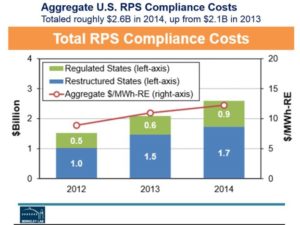States Meeting Renewable Portfolio Standards; not without cost
A new report by the Lawrence Berkeley National Laboratory (LNBL) analyzing the benefits and impacts of renewable portfolio standards in the U.S. finds that almost all of the 29 states with RPS programs on track to successfully meet their renewable goals, collectively creating 215 TWh of demand in 2015. However, more ambitious goals have also led to a rise in compliance costs over the last few years (from $11MWh in 2013 to $12MWh in 2014), and the current structure of most RPS portfolios are not sufficiently incentivizing the creation of new generation capacity. The study also noted that, while RPS programs have been very successful in meeting their stated goals, they have not led to a consensus on what the larger goals of such programs should be.
Even though no two state policies are the same, the national RPS achievement average in 2014 was 95%. And while the adoption of new RPS programs has stalled (largely due to the politicization of renewable energy), states with existing portfolios have continued to increase their RPS targets. Both New York and Hawaii set targets of 50% renewables by 2030 and Hawai’i aiming to reach 100% by 2045.
The study found that 2015 RPS targets created a demand of 215 TWh, and that this demand is estimated to rise to 431 TWh in 2030. The study also finds that several emerging trends – including cost-competitive wind in Texas and utility-scale solar in the Southwest – have sharply reduced the proportional role of RPS in overall annual renewables builds, from 71% in 2013 to 46% in 2015. Solar procurement is expected to continue to gain renewable market share.
The study addresses the issue of generation capacity growth, which has not kept pace with demand. Because the structures of many RPS programs focus on short-term goals over incentivizing long-term generation capacity, several states are now looking to regulated utilities to fill the gap, by requiring that they contract from renewable energy developers.
This requirement is one of the reasons cited by the study for the overall rise of the cost of compliance, which increased from $11MWh in 2013 to $12MWh in 2014. Retail customers have seen this increase reflected in their bill, with RPS compliance growing from 0.8% of the total billing in 2012 to 1.3% in 2014.
However, the lead author of the study, Galen Barbose, was confident that RPS compliance costs would begin to plateau over the next few years, given that: (1) many states recently reset their renewable targets, affecting rates only in the short-term; (2) renewables will continue to get cheaper; both per unit and as compared to non-renewable generation; and (3) most RPS policy have cost containment ‘safety valve’ mechanisms in place.
The study notes that despite the success of states nationwide in meeting their RPS targets, there is no national consensus on the underlying reason for having such targets: Is it decarbonization? Energy independence? Job creation? The lack of consensus reflects the larger politicization of fossil fuels and renewable energy policy in the U.S., and probably won’t be going away any time soon. Still – given the projected growth of renewable energy – answering the question of why may soon be a moot point.
The study was published by the Electricity Markets and Policy Group of the Lawrence Berkeley National Laboratory, a national research and policy group.



